Decision Technique Analysis of Catanza Technologies
VerifiedAdded on 2022/09/15
|16
|3938
|33
AI Summary
Contribute Materials
Your contribution can guide someone’s learning journey. Share your
documents today.
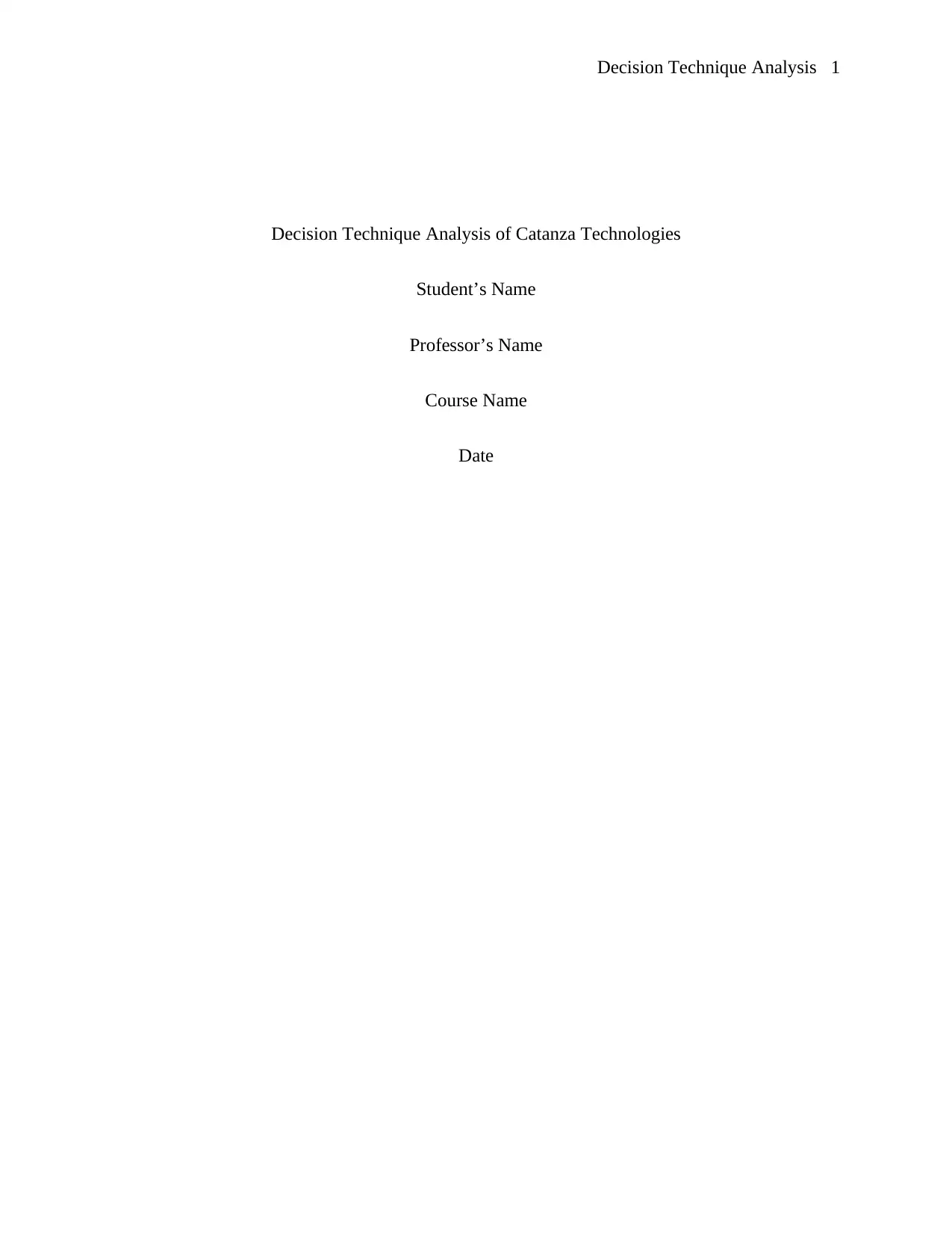
Decision Technique Analysis 1
Decision Technique Analysis of Catanza Technologies
Student’s Name
Professor’s Name
Course Name
Date
Decision Technique Analysis of Catanza Technologies
Student’s Name
Professor’s Name
Course Name
Date
Secure Best Marks with AI Grader
Need help grading? Try our AI Grader for instant feedback on your assignments.
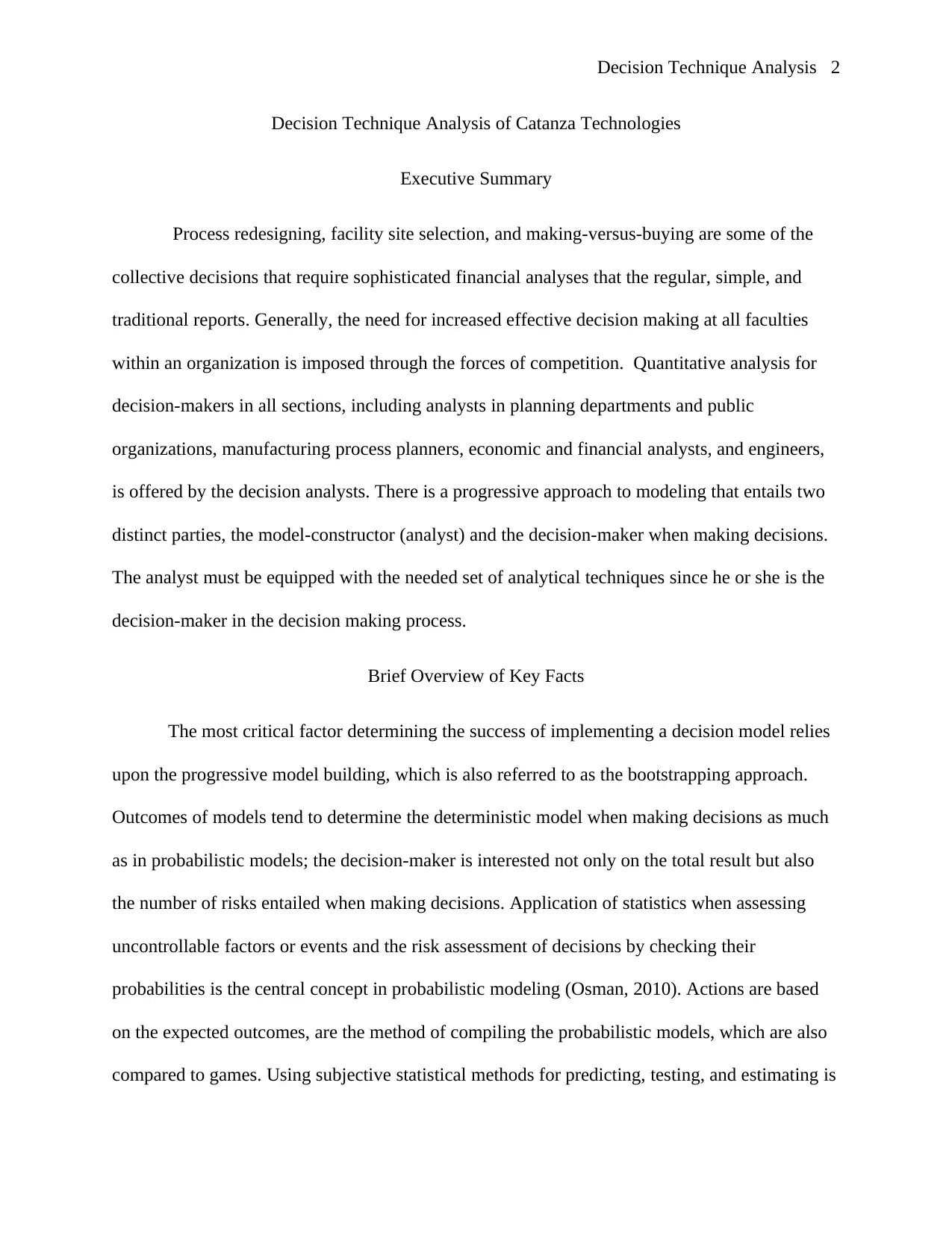
Decision Technique Analysis 2
Decision Technique Analysis of Catanza Technologies
Executive Summary
Process redesigning, facility site selection, and making-versus-buying are some of the
collective decisions that require sophisticated financial analyses that the regular, simple, and
traditional reports. Generally, the need for increased effective decision making at all faculties
within an organization is imposed through the forces of competition. Quantitative analysis for
decision-makers in all sections, including analysts in planning departments and public
organizations, manufacturing process planners, economic and financial analysts, and engineers,
is offered by the decision analysts. There is a progressive approach to modeling that entails two
distinct parties, the model-constructor (analyst) and the decision-maker when making decisions.
The analyst must be equipped with the needed set of analytical techniques since he or she is the
decision-maker in the decision making process.
Brief Overview of Key Facts
The most critical factor determining the success of implementing a decision model relies
upon the progressive model building, which is also referred to as the bootstrapping approach.
Outcomes of models tend to determine the deterministic model when making decisions as much
as in probabilistic models; the decision-maker is interested not only on the total result but also
the number of risks entailed when making decisions. Application of statistics when assessing
uncontrollable factors or events and the risk assessment of decisions by checking their
probabilities is the central concept in probabilistic modeling (Osman, 2010). Actions are based
on the expected outcomes, are the method of compiling the probabilistic models, which are also
compared to games. Using subjective statistical methods for predicting, testing, and estimating is
Decision Technique Analysis of Catanza Technologies
Executive Summary
Process redesigning, facility site selection, and making-versus-buying are some of the
collective decisions that require sophisticated financial analyses that the regular, simple, and
traditional reports. Generally, the need for increased effective decision making at all faculties
within an organization is imposed through the forces of competition. Quantitative analysis for
decision-makers in all sections, including analysts in planning departments and public
organizations, manufacturing process planners, economic and financial analysts, and engineers,
is offered by the decision analysts. There is a progressive approach to modeling that entails two
distinct parties, the model-constructor (analyst) and the decision-maker when making decisions.
The analyst must be equipped with the needed set of analytical techniques since he or she is the
decision-maker in the decision making process.
Brief Overview of Key Facts
The most critical factor determining the success of implementing a decision model relies
upon the progressive model building, which is also referred to as the bootstrapping approach.
Outcomes of models tend to determine the deterministic model when making decisions as much
as in probabilistic models; the decision-maker is interested not only on the total result but also
the number of risks entailed when making decisions. Application of statistics when assessing
uncontrollable factors or events and the risk assessment of decisions by checking their
probabilities is the central concept in probabilistic modeling (Osman, 2010). Actions are based
on the expected outcomes, are the method of compiling the probabilistic models, which are also
compared to games. Using subjective statistical methods for predicting, testing, and estimating is
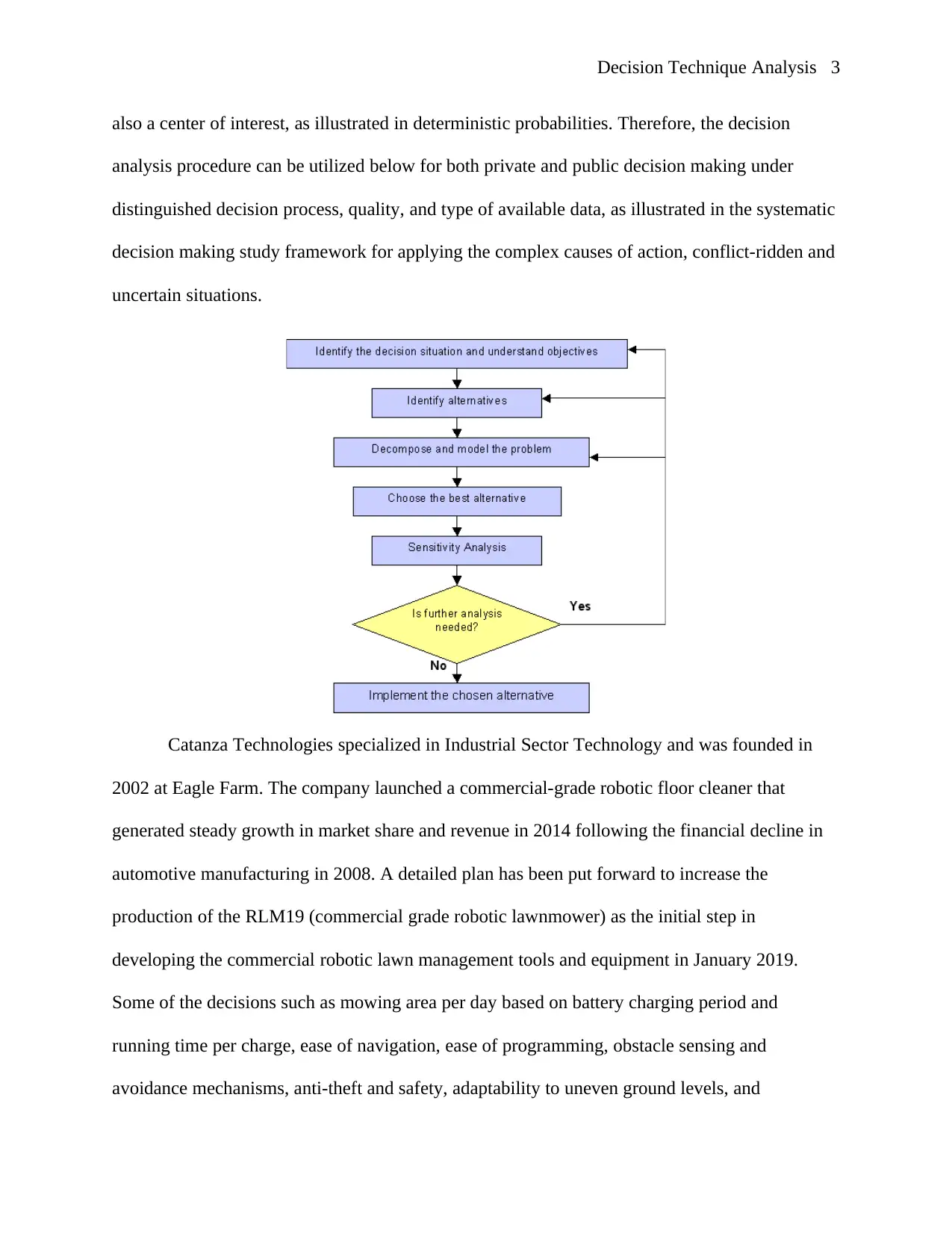
Decision Technique Analysis 3
also a center of interest, as illustrated in deterministic probabilities. Therefore, the decision
analysis procedure can be utilized below for both private and public decision making under
distinguished decision process, quality, and type of available data, as illustrated in the systematic
decision making study framework for applying the complex causes of action, conflict-ridden and
uncertain situations.
Catanza Technologies specialized in Industrial Sector Technology and was founded in
2002 at Eagle Farm. The company launched a commercial-grade robotic floor cleaner that
generated steady growth in market share and revenue in 2014 following the financial decline in
automotive manufacturing in 2008. A detailed plan has been put forward to increase the
production of the RLM19 (commercial grade robotic lawnmower) as the initial step in
developing the commercial robotic lawn management tools and equipment in January 2019.
Some of the decisions such as mowing area per day based on battery charging period and
running time per charge, ease of navigation, ease of programming, obstacle sensing and
avoidance mechanisms, anti-theft and safety, adaptability to uneven ground levels, and
also a center of interest, as illustrated in deterministic probabilities. Therefore, the decision
analysis procedure can be utilized below for both private and public decision making under
distinguished decision process, quality, and type of available data, as illustrated in the systematic
decision making study framework for applying the complex causes of action, conflict-ridden and
uncertain situations.
Catanza Technologies specialized in Industrial Sector Technology and was founded in
2002 at Eagle Farm. The company launched a commercial-grade robotic floor cleaner that
generated steady growth in market share and revenue in 2014 following the financial decline in
automotive manufacturing in 2008. A detailed plan has been put forward to increase the
production of the RLM19 (commercial grade robotic lawnmower) as the initial step in
developing the commercial robotic lawn management tools and equipment in January 2019.
Some of the decisions such as mowing area per day based on battery charging period and
running time per charge, ease of navigation, ease of programming, obstacle sensing and
avoidance mechanisms, anti-theft and safety, adaptability to uneven ground levels, and
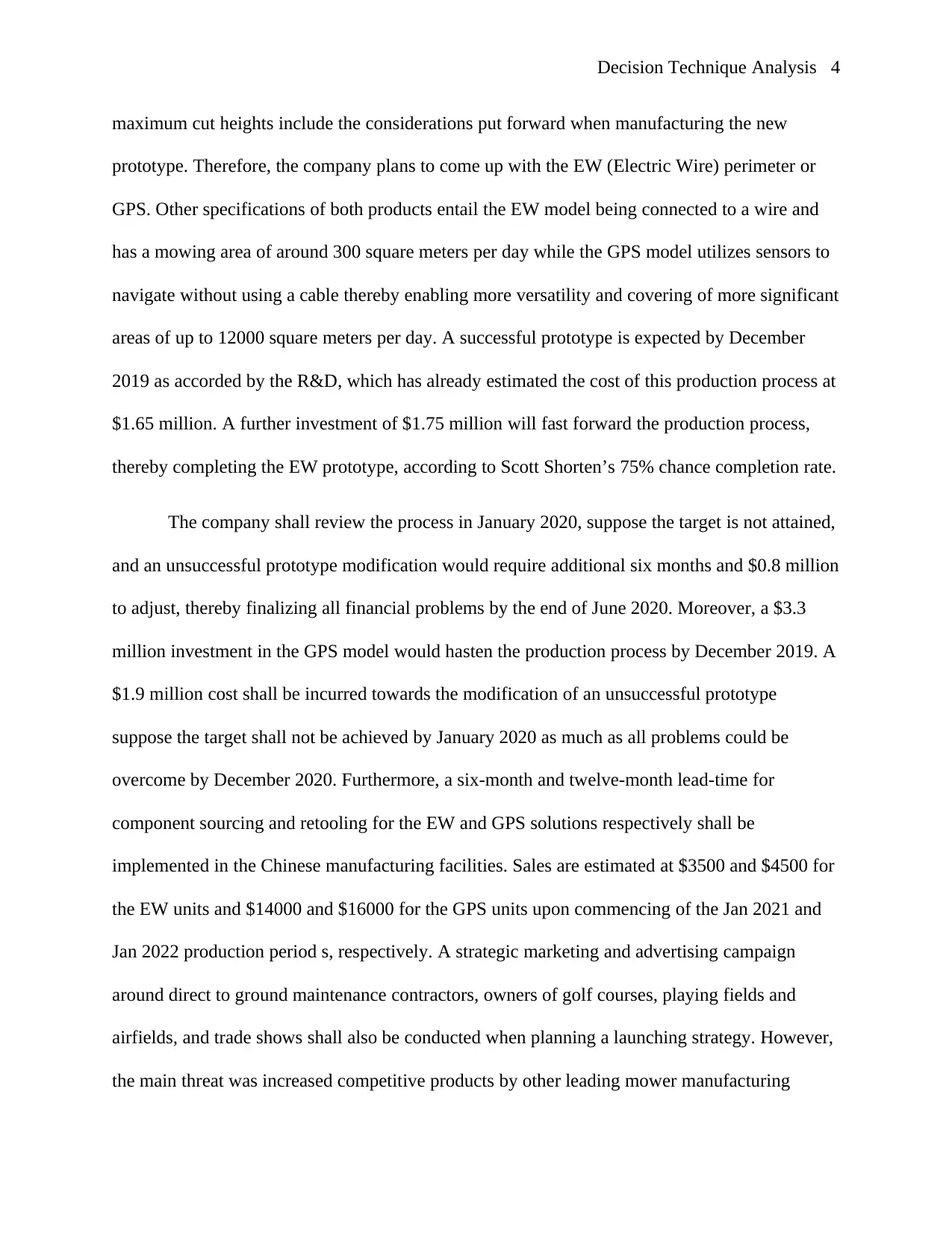
Decision Technique Analysis 4
maximum cut heights include the considerations put forward when manufacturing the new
prototype. Therefore, the company plans to come up with the EW (Electric Wire) perimeter or
GPS. Other specifications of both products entail the EW model being connected to a wire and
has a mowing area of around 300 square meters per day while the GPS model utilizes sensors to
navigate without using a cable thereby enabling more versatility and covering of more significant
areas of up to 12000 square meters per day. A successful prototype is expected by December
2019 as accorded by the R&D, which has already estimated the cost of this production process at
$1.65 million. A further investment of $1.75 million will fast forward the production process,
thereby completing the EW prototype, according to Scott Shorten’s 75% chance completion rate.
The company shall review the process in January 2020, suppose the target is not attained,
and an unsuccessful prototype modification would require additional six months and $0.8 million
to adjust, thereby finalizing all financial problems by the end of June 2020. Moreover, a $3.3
million investment in the GPS model would hasten the production process by December 2019. A
$1.9 million cost shall be incurred towards the modification of an unsuccessful prototype
suppose the target shall not be achieved by January 2020 as much as all problems could be
overcome by December 2020. Furthermore, a six-month and twelve-month lead-time for
component sourcing and retooling for the EW and GPS solutions respectively shall be
implemented in the Chinese manufacturing facilities. Sales are estimated at $3500 and $4500 for
the EW units and $14000 and $16000 for the GPS units upon commencing of the Jan 2021 and
Jan 2022 production period s, respectively. A strategic marketing and advertising campaign
around direct to ground maintenance contractors, owners of golf courses, playing fields and
airfields, and trade shows shall also be conducted when planning a launching strategy. However,
the main threat was increased competitive products by other leading mower manufacturing
maximum cut heights include the considerations put forward when manufacturing the new
prototype. Therefore, the company plans to come up with the EW (Electric Wire) perimeter or
GPS. Other specifications of both products entail the EW model being connected to a wire and
has a mowing area of around 300 square meters per day while the GPS model utilizes sensors to
navigate without using a cable thereby enabling more versatility and covering of more significant
areas of up to 12000 square meters per day. A successful prototype is expected by December
2019 as accorded by the R&D, which has already estimated the cost of this production process at
$1.65 million. A further investment of $1.75 million will fast forward the production process,
thereby completing the EW prototype, according to Scott Shorten’s 75% chance completion rate.
The company shall review the process in January 2020, suppose the target is not attained,
and an unsuccessful prototype modification would require additional six months and $0.8 million
to adjust, thereby finalizing all financial problems by the end of June 2020. Moreover, a $3.3
million investment in the GPS model would hasten the production process by December 2019. A
$1.9 million cost shall be incurred towards the modification of an unsuccessful prototype
suppose the target shall not be achieved by January 2020 as much as all problems could be
overcome by December 2020. Furthermore, a six-month and twelve-month lead-time for
component sourcing and retooling for the EW and GPS solutions respectively shall be
implemented in the Chinese manufacturing facilities. Sales are estimated at $3500 and $4500 for
the EW units and $14000 and $16000 for the GPS units upon commencing of the Jan 2021 and
Jan 2022 production period s, respectively. A strategic marketing and advertising campaign
around direct to ground maintenance contractors, owners of golf courses, playing fields and
airfields, and trade shows shall also be conducted when planning a launching strategy. However,
the main threat was increased competitive products by other leading mower manufacturing
Secure Best Marks with AI Grader
Need help grading? Try our AI Grader for instant feedback on your assignments.
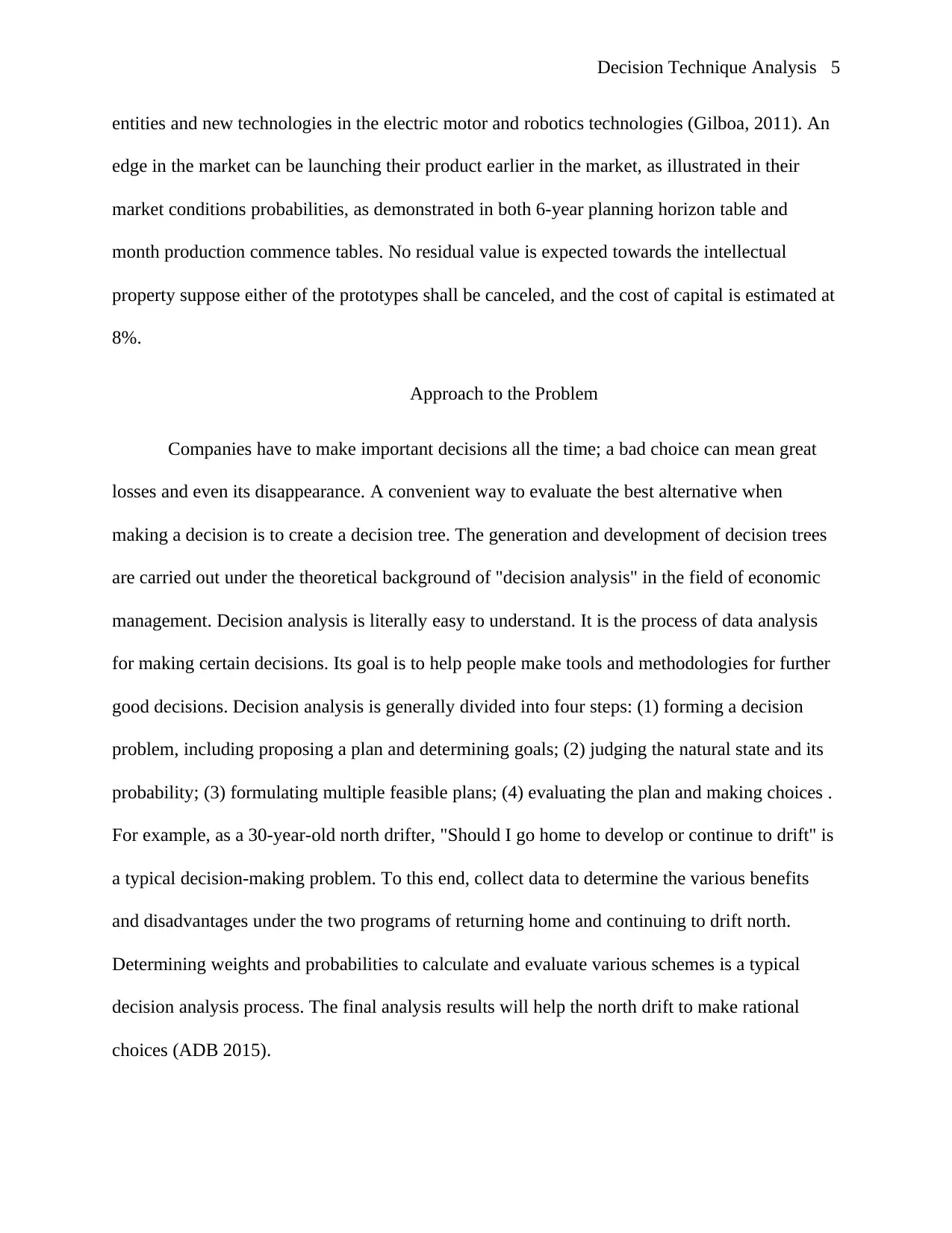
Decision Technique Analysis 5
entities and new technologies in the electric motor and robotics technologies (Gilboa, 2011). An
edge in the market can be launching their product earlier in the market, as illustrated in their
market conditions probabilities, as demonstrated in both 6-year planning horizon table and
month production commence tables. No residual value is expected towards the intellectual
property suppose either of the prototypes shall be canceled, and the cost of capital is estimated at
8%.
Approach to the Problem
Companies have to make important decisions all the time; a bad choice can mean great
losses and even its disappearance. A convenient way to evaluate the best alternative when
making a decision is to create a decision tree. The generation and development of decision trees
are carried out under the theoretical background of "decision analysis" in the field of economic
management. Decision analysis is literally easy to understand. It is the process of data analysis
for making certain decisions. Its goal is to help people make tools and methodologies for further
good decisions. Decision analysis is generally divided into four steps: (1) forming a decision
problem, including proposing a plan and determining goals; (2) judging the natural state and its
probability; (3) formulating multiple feasible plans; (4) evaluating the plan and making choices .
For example, as a 30-year-old north drifter, "Should I go home to develop or continue to drift" is
a typical decision-making problem. To this end, collect data to determine the various benefits
and disadvantages under the two programs of returning home and continuing to drift north.
Determining weights and probabilities to calculate and evaluate various schemes is a typical
decision analysis process. The final analysis results will help the north drift to make rational
choices (ADB 2015).
entities and new technologies in the electric motor and robotics technologies (Gilboa, 2011). An
edge in the market can be launching their product earlier in the market, as illustrated in their
market conditions probabilities, as demonstrated in both 6-year planning horizon table and
month production commence tables. No residual value is expected towards the intellectual
property suppose either of the prototypes shall be canceled, and the cost of capital is estimated at
8%.
Approach to the Problem
Companies have to make important decisions all the time; a bad choice can mean great
losses and even its disappearance. A convenient way to evaluate the best alternative when
making a decision is to create a decision tree. The generation and development of decision trees
are carried out under the theoretical background of "decision analysis" in the field of economic
management. Decision analysis is literally easy to understand. It is the process of data analysis
for making certain decisions. Its goal is to help people make tools and methodologies for further
good decisions. Decision analysis is generally divided into four steps: (1) forming a decision
problem, including proposing a plan and determining goals; (2) judging the natural state and its
probability; (3) formulating multiple feasible plans; (4) evaluating the plan and making choices .
For example, as a 30-year-old north drifter, "Should I go home to develop or continue to drift" is
a typical decision-making problem. To this end, collect data to determine the various benefits
and disadvantages under the two programs of returning home and continuing to drift north.
Determining weights and probabilities to calculate and evaluate various schemes is a typical
decision analysis process. The final analysis results will help the north drift to make rational
choices (ADB 2015).
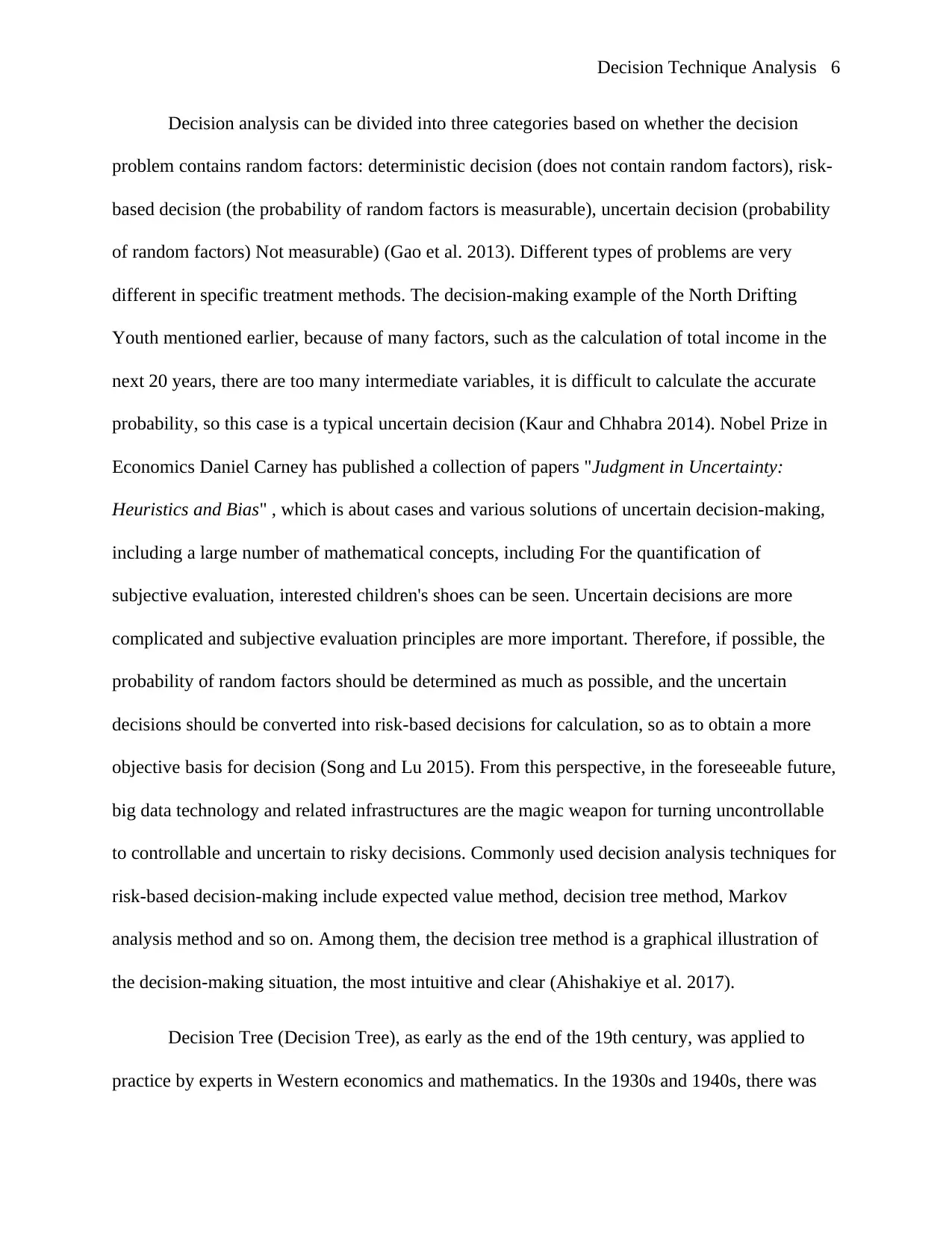
Decision Technique Analysis 6
Decision analysis can be divided into three categories based on whether the decision
problem contains random factors: deterministic decision (does not contain random factors), risk-
based decision (the probability of random factors is measurable), uncertain decision (probability
of random factors) Not measurable) (Gao et al. 2013). Different types of problems are very
different in specific treatment methods. The decision-making example of the North Drifting
Youth mentioned earlier, because of many factors, such as the calculation of total income in the
next 20 years, there are too many intermediate variables, it is difficult to calculate the accurate
probability, so this case is a typical uncertain decision (Kaur and Chhabra 2014). Nobel Prize in
Economics Daniel Carney has published a collection of papers "Judgment in Uncertainty:
Heuristics and Bias" , which is about cases and various solutions of uncertain decision-making,
including a large number of mathematical concepts, including For the quantification of
subjective evaluation, interested children's shoes can be seen. Uncertain decisions are more
complicated and subjective evaluation principles are more important. Therefore, if possible, the
probability of random factors should be determined as much as possible, and the uncertain
decisions should be converted into risk-based decisions for calculation, so as to obtain a more
objective basis for decision (Song and Lu 2015). From this perspective, in the foreseeable future,
big data technology and related infrastructures are the magic weapon for turning uncontrollable
to controllable and uncertain to risky decisions. Commonly used decision analysis techniques for
risk-based decision-making include expected value method, decision tree method, Markov
analysis method and so on. Among them, the decision tree method is a graphical illustration of
the decision-making situation, the most intuitive and clear (Ahishakiye et al. 2017).
Decision Tree (Decision Tree), as early as the end of the 19th century, was applied to
practice by experts in Western economics and mathematics. In the 1930s and 1940s, there was
Decision analysis can be divided into three categories based on whether the decision
problem contains random factors: deterministic decision (does not contain random factors), risk-
based decision (the probability of random factors is measurable), uncertain decision (probability
of random factors) Not measurable) (Gao et al. 2013). Different types of problems are very
different in specific treatment methods. The decision-making example of the North Drifting
Youth mentioned earlier, because of many factors, such as the calculation of total income in the
next 20 years, there are too many intermediate variables, it is difficult to calculate the accurate
probability, so this case is a typical uncertain decision (Kaur and Chhabra 2014). Nobel Prize in
Economics Daniel Carney has published a collection of papers "Judgment in Uncertainty:
Heuristics and Bias" , which is about cases and various solutions of uncertain decision-making,
including a large number of mathematical concepts, including For the quantification of
subjective evaluation, interested children's shoes can be seen. Uncertain decisions are more
complicated and subjective evaluation principles are more important. Therefore, if possible, the
probability of random factors should be determined as much as possible, and the uncertain
decisions should be converted into risk-based decisions for calculation, so as to obtain a more
objective basis for decision (Song and Lu 2015). From this perspective, in the foreseeable future,
big data technology and related infrastructures are the magic weapon for turning uncontrollable
to controllable and uncertain to risky decisions. Commonly used decision analysis techniques for
risk-based decision-making include expected value method, decision tree method, Markov
analysis method and so on. Among them, the decision tree method is a graphical illustration of
the decision-making situation, the most intuitive and clear (Ahishakiye et al. 2017).
Decision Tree (Decision Tree), as early as the end of the 19th century, was applied to
practice by experts in Western economics and mathematics. In the 1930s and 1940s, there was
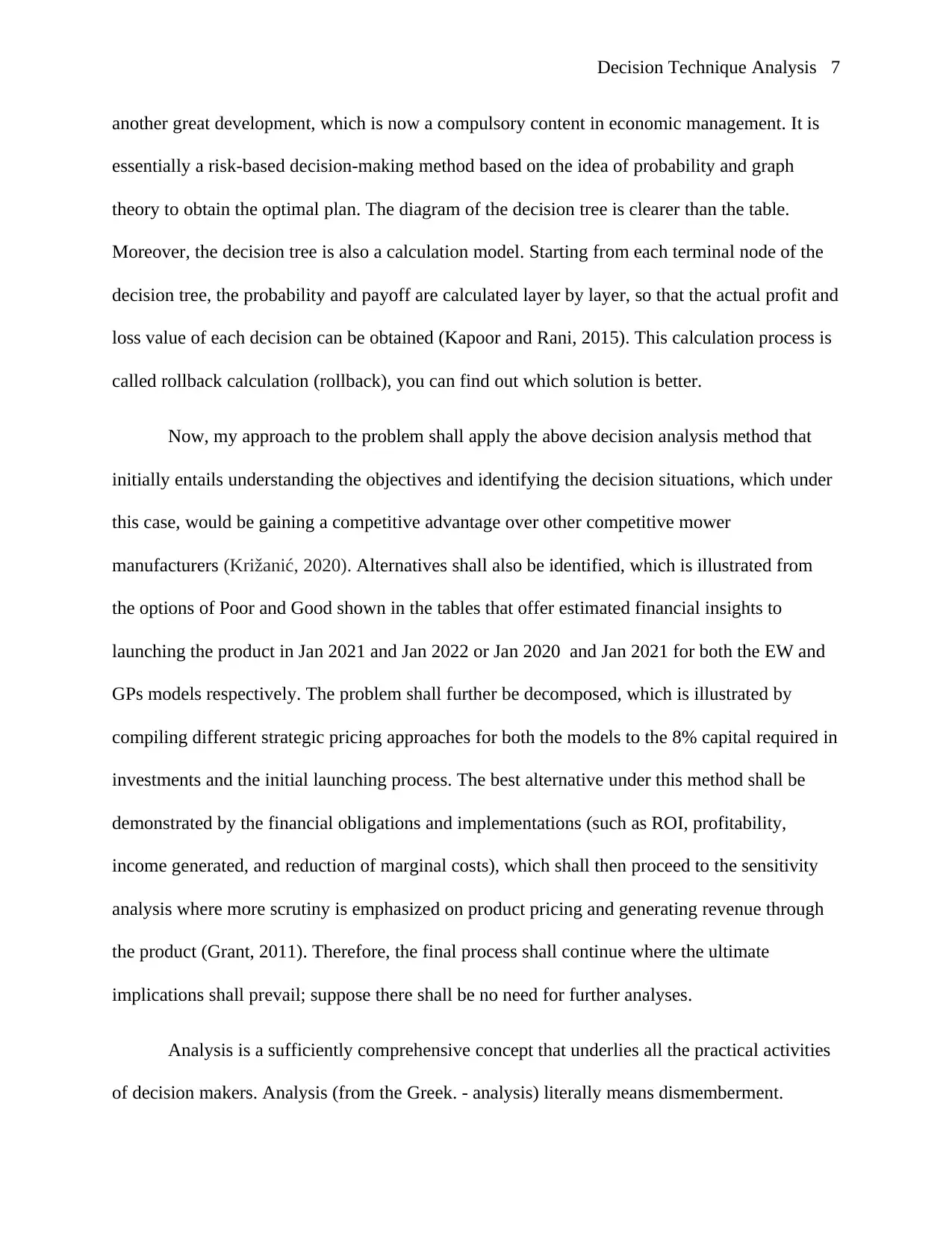
Decision Technique Analysis 7
another great development, which is now a compulsory content in economic management. It is
essentially a risk-based decision-making method based on the idea of probability and graph
theory to obtain the optimal plan. The diagram of the decision tree is clearer than the table.
Moreover, the decision tree is also a calculation model. Starting from each terminal node of the
decision tree, the probability and payoff are calculated layer by layer, so that the actual profit and
loss value of each decision can be obtained (Kapoor and Rani, 2015). This calculation process is
called rollback calculation (rollback), you can find out which solution is better.
Now, my approach to the problem shall apply the above decision analysis method that
initially entails understanding the objectives and identifying the decision situations, which under
this case, would be gaining a competitive advantage over other competitive mower
manufacturers (Križanić, 2020). Alternatives shall also be identified, which is illustrated from
the options of Poor and Good shown in the tables that offer estimated financial insights to
launching the product in Jan 2021 and Jan 2022 or Jan 2020 and Jan 2021 for both the EW and
GPs models respectively. The problem shall further be decomposed, which is illustrated by
compiling different strategic pricing approaches for both the models to the 8% capital required in
investments and the initial launching process. The best alternative under this method shall be
demonstrated by the financial obligations and implementations (such as ROI, profitability,
income generated, and reduction of marginal costs), which shall then proceed to the sensitivity
analysis where more scrutiny is emphasized on product pricing and generating revenue through
the product (Grant, 2011). Therefore, the final process shall continue where the ultimate
implications shall prevail; suppose there shall be no need for further analyses.
Analysis is a sufficiently comprehensive concept that underlies all the practical activities
of decision makers. Analysis (from the Greek. - analysis) literally means dismemberment.
another great development, which is now a compulsory content in economic management. It is
essentially a risk-based decision-making method based on the idea of probability and graph
theory to obtain the optimal plan. The diagram of the decision tree is clearer than the table.
Moreover, the decision tree is also a calculation model. Starting from each terminal node of the
decision tree, the probability and payoff are calculated layer by layer, so that the actual profit and
loss value of each decision can be obtained (Kapoor and Rani, 2015). This calculation process is
called rollback calculation (rollback), you can find out which solution is better.
Now, my approach to the problem shall apply the above decision analysis method that
initially entails understanding the objectives and identifying the decision situations, which under
this case, would be gaining a competitive advantage over other competitive mower
manufacturers (Križanić, 2020). Alternatives shall also be identified, which is illustrated from
the options of Poor and Good shown in the tables that offer estimated financial insights to
launching the product in Jan 2021 and Jan 2022 or Jan 2020 and Jan 2021 for both the EW and
GPs models respectively. The problem shall further be decomposed, which is illustrated by
compiling different strategic pricing approaches for both the models to the 8% capital required in
investments and the initial launching process. The best alternative under this method shall be
demonstrated by the financial obligations and implementations (such as ROI, profitability,
income generated, and reduction of marginal costs), which shall then proceed to the sensitivity
analysis where more scrutiny is emphasized on product pricing and generating revenue through
the product (Grant, 2011). Therefore, the final process shall continue where the ultimate
implications shall prevail; suppose there shall be no need for further analyses.
Analysis is a sufficiently comprehensive concept that underlies all the practical activities
of decision makers. Analysis (from the Greek. - analysis) literally means dismemberment.
Paraphrase This Document
Need a fresh take? Get an instant paraphrase of this document with our AI Paraphraser
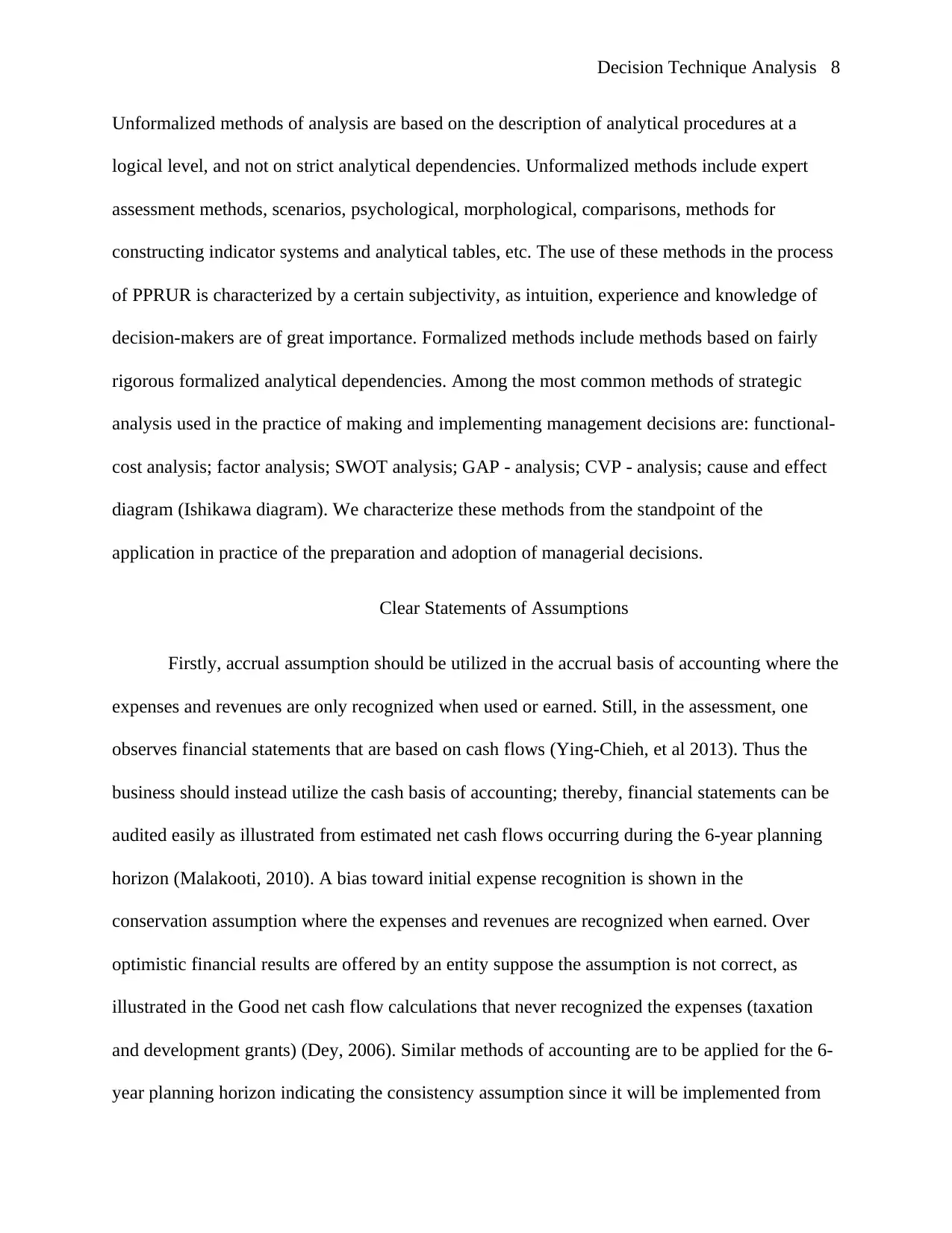
Decision Technique Analysis 8
Unformalized methods of analysis are based on the description of analytical procedures at a
logical level, and not on strict analytical dependencies. Unformalized methods include expert
assessment methods, scenarios, psychological, morphological, comparisons, methods for
constructing indicator systems and analytical tables, etc. The use of these methods in the process
of PPRUR is characterized by a certain subjectivity, as intuition, experience and knowledge of
decision-makers are of great importance. Formalized methods include methods based on fairly
rigorous formalized analytical dependencies. Among the most common methods of strategic
analysis used in the practice of making and implementing management decisions are: functional-
cost analysis; factor analysis; SWOT analysis; GAP - analysis; CVP - analysis; cause and effect
diagram (Ishikawa diagram). We characterize these methods from the standpoint of the
application in practice of the preparation and adoption of managerial decisions.
Clear Statements of Assumptions
Firstly, accrual assumption should be utilized in the accrual basis of accounting where the
expenses and revenues are only recognized when used or earned. Still, in the assessment, one
observes financial statements that are based on cash flows (Ying-Chieh, et al 2013). Thus the
business should instead utilize the cash basis of accounting; thereby, financial statements can be
audited easily as illustrated from estimated net cash flows occurring during the 6-year planning
horizon (Malakooti, 2010). A bias toward initial expense recognition is shown in the
conservation assumption where the expenses and revenues are recognized when earned. Over
optimistic financial results are offered by an entity suppose the assumption is not correct, as
illustrated in the Good net cash flow calculations that never recognized the expenses (taxation
and development grants) (Dey, 2006). Similar methods of accounting are to be applied for the 6-
year planning horizon indicating the consistency assumption since it will be implemented from
Unformalized methods of analysis are based on the description of analytical procedures at a
logical level, and not on strict analytical dependencies. Unformalized methods include expert
assessment methods, scenarios, psychological, morphological, comparisons, methods for
constructing indicator systems and analytical tables, etc. The use of these methods in the process
of PPRUR is characterized by a certain subjectivity, as intuition, experience and knowledge of
decision-makers are of great importance. Formalized methods include methods based on fairly
rigorous formalized analytical dependencies. Among the most common methods of strategic
analysis used in the practice of making and implementing management decisions are: functional-
cost analysis; factor analysis; SWOT analysis; GAP - analysis; CVP - analysis; cause and effect
diagram (Ishikawa diagram). We characterize these methods from the standpoint of the
application in practice of the preparation and adoption of managerial decisions.
Clear Statements of Assumptions
Firstly, accrual assumption should be utilized in the accrual basis of accounting where the
expenses and revenues are only recognized when used or earned. Still, in the assessment, one
observes financial statements that are based on cash flows (Ying-Chieh, et al 2013). Thus the
business should instead utilize the cash basis of accounting; thereby, financial statements can be
audited easily as illustrated from estimated net cash flows occurring during the 6-year planning
horizon (Malakooti, 2010). A bias toward initial expense recognition is shown in the
conservation assumption where the expenses and revenues are recognized when earned. Over
optimistic financial results are offered by an entity suppose the assumption is not correct, as
illustrated in the Good net cash flow calculations that never recognized the expenses (taxation
and development grants) (Dey, 2006). Similar methods of accounting are to be applied for the 6-
year planning horizon indicating the consistency assumption since it will be implemented from
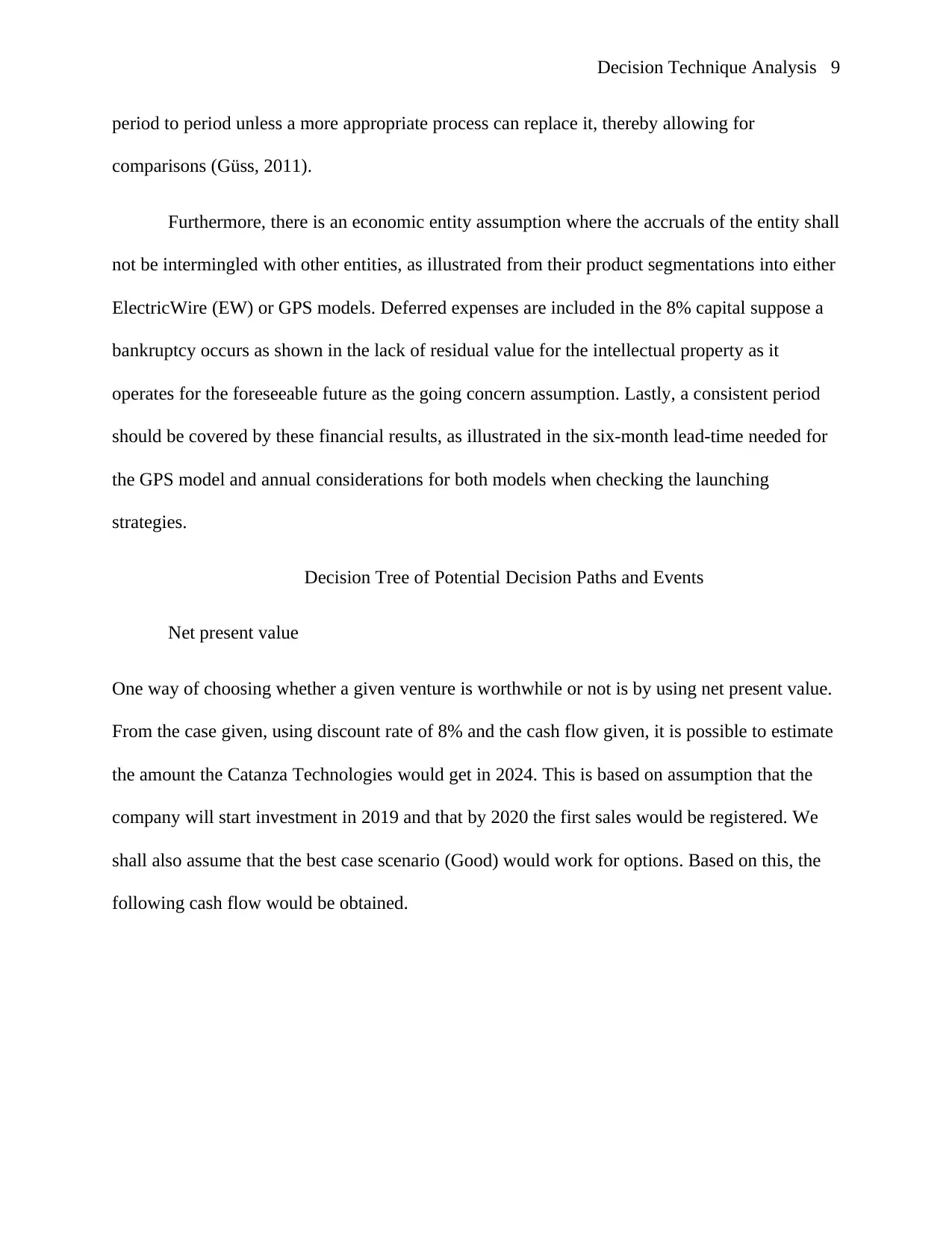
Decision Technique Analysis 9
period to period unless a more appropriate process can replace it, thereby allowing for
comparisons (Güss, 2011).
Furthermore, there is an economic entity assumption where the accruals of the entity shall
not be intermingled with other entities, as illustrated from their product segmentations into either
ElectricWire (EW) or GPS models. Deferred expenses are included in the 8% capital suppose a
bankruptcy occurs as shown in the lack of residual value for the intellectual property as it
operates for the foreseeable future as the going concern assumption. Lastly, a consistent period
should be covered by these financial results, as illustrated in the six-month lead-time needed for
the GPS model and annual considerations for both models when checking the launching
strategies.
Decision Tree of Potential Decision Paths and Events
Net present value
One way of choosing whether a given venture is worthwhile or not is by using net present value.
From the case given, using discount rate of 8% and the cash flow given, it is possible to estimate
the amount the Catanza Technologies would get in 2024. This is based on assumption that the
company will start investment in 2019 and that by 2020 the first sales would be registered. We
shall also assume that the best case scenario (Good) would work for options. Based on this, the
following cash flow would be obtained.
period to period unless a more appropriate process can replace it, thereby allowing for
comparisons (Güss, 2011).
Furthermore, there is an economic entity assumption where the accruals of the entity shall
not be intermingled with other entities, as illustrated from their product segmentations into either
ElectricWire (EW) or GPS models. Deferred expenses are included in the 8% capital suppose a
bankruptcy occurs as shown in the lack of residual value for the intellectual property as it
operates for the foreseeable future as the going concern assumption. Lastly, a consistent period
should be covered by these financial results, as illustrated in the six-month lead-time needed for
the GPS model and annual considerations for both models when checking the launching
strategies.
Decision Tree of Potential Decision Paths and Events
Net present value
One way of choosing whether a given venture is worthwhile or not is by using net present value.
From the case given, using discount rate of 8% and the cash flow given, it is possible to estimate
the amount the Catanza Technologies would get in 2024. This is based on assumption that the
company will start investment in 2019 and that by 2020 the first sales would be registered. We
shall also assume that the best case scenario (Good) would work for options. Based on this, the
following cash flow would be obtained.
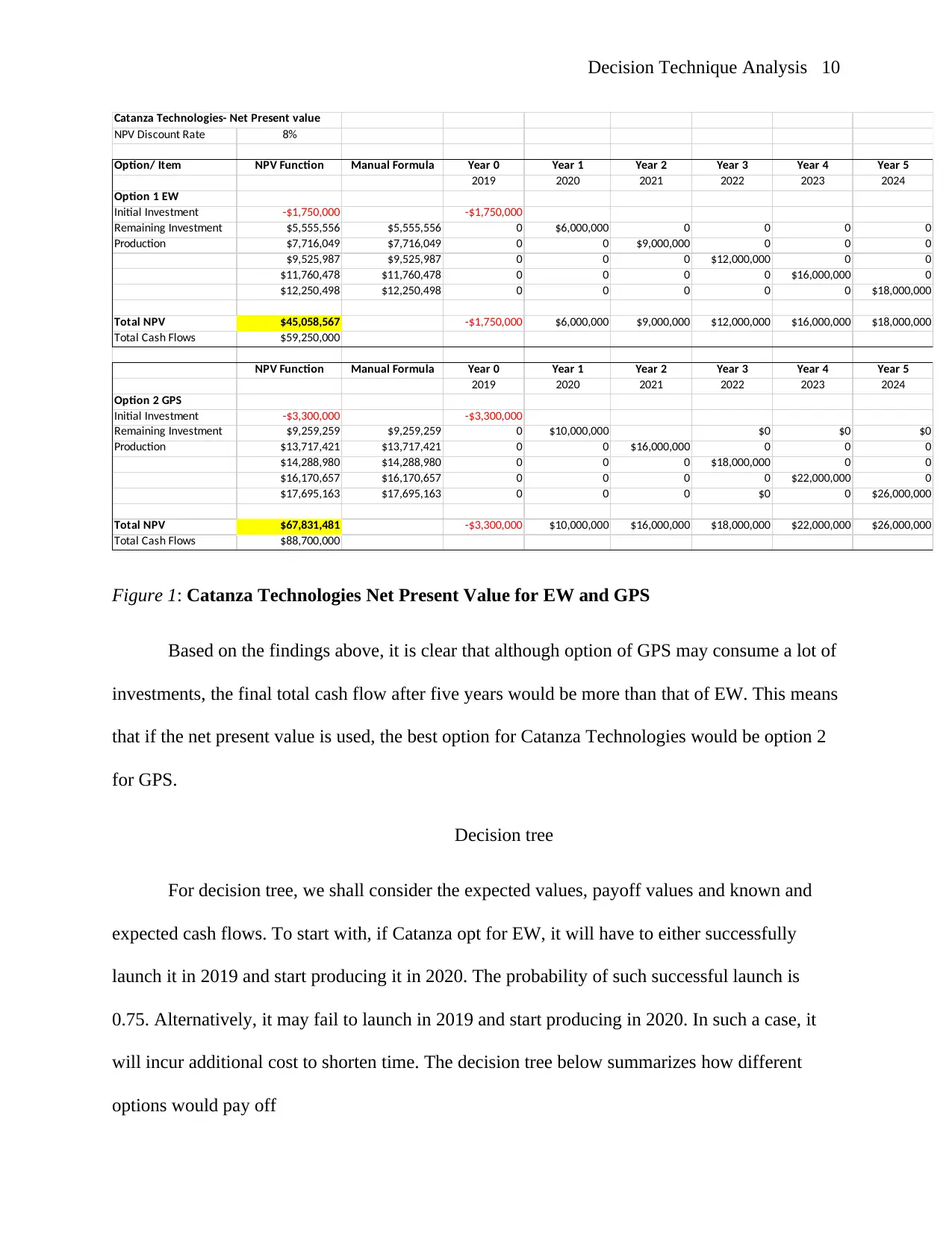
Decision Technique Analysis 10
Catanza Technologies- Net Present value
NPV Discount Rate 8%
Option/ Item NPV Function Manual Formula Year 0 Year 1 Year 2 Year 3 Year 4 Year 5
2019 2020 2021 2022 2023 2024
Option 1 EW
Initial Investment -$1,750,000 -$1,750,000
Remaining Investment $5,555,556 $5,555,556 0 $6,000,000 0 0 0 0
Production $7,716,049 $7,716,049 0 0 $9,000,000 0 0 0
$9,525,987 $9,525,987 0 0 0 $12,000,000 0 0
$11,760,478 $11,760,478 0 0 0 0 $16,000,000 0
$12,250,498 $12,250,498 0 0 0 0 0 $18,000,000
Total NPV $45,058,567 -$1,750,000 $6,000,000 $9,000,000 $12,000,000 $16,000,000 $18,000,000
Total Cash Flows $59,250,000
NPV Function Manual Formula Year 0 Year 1 Year 2 Year 3 Year 4 Year 5
2019 2020 2021 2022 2023 2024
Option 2 GPS
Initial Investment -$3,300,000 -$3,300,000
Remaining Investment $9,259,259 $9,259,259 0 $10,000,000 $0 $0 $0
Production $13,717,421 $13,717,421 0 0 $16,000,000 0 0 0
$14,288,980 $14,288,980 0 0 0 $18,000,000 0 0
$16,170,657 $16,170,657 0 0 0 0 $22,000,000 0
$17,695,163 $17,695,163 0 0 0 $0 0 $26,000,000
Total NPV $67,831,481 -$3,300,000 $10,000,000 $16,000,000 $18,000,000 $22,000,000 $26,000,000
Total Cash Flows $88,700,000
Figure 1: Catanza Technologies Net Present Value for EW and GPS
Based on the findings above, it is clear that although option of GPS may consume a lot of
investments, the final total cash flow after five years would be more than that of EW. This means
that if the net present value is used, the best option for Catanza Technologies would be option 2
for GPS.
Decision tree
For decision tree, we shall consider the expected values, payoff values and known and
expected cash flows. To start with, if Catanza opt for EW, it will have to either successfully
launch it in 2019 and start producing it in 2020. The probability of such successful launch is
0.75. Alternatively, it may fail to launch in 2019 and start producing in 2020. In such a case, it
will incur additional cost to shorten time. The decision tree below summarizes how different
options would pay off
Catanza Technologies- Net Present value
NPV Discount Rate 8%
Option/ Item NPV Function Manual Formula Year 0 Year 1 Year 2 Year 3 Year 4 Year 5
2019 2020 2021 2022 2023 2024
Option 1 EW
Initial Investment -$1,750,000 -$1,750,000
Remaining Investment $5,555,556 $5,555,556 0 $6,000,000 0 0 0 0
Production $7,716,049 $7,716,049 0 0 $9,000,000 0 0 0
$9,525,987 $9,525,987 0 0 0 $12,000,000 0 0
$11,760,478 $11,760,478 0 0 0 0 $16,000,000 0
$12,250,498 $12,250,498 0 0 0 0 0 $18,000,000
Total NPV $45,058,567 -$1,750,000 $6,000,000 $9,000,000 $12,000,000 $16,000,000 $18,000,000
Total Cash Flows $59,250,000
NPV Function Manual Formula Year 0 Year 1 Year 2 Year 3 Year 4 Year 5
2019 2020 2021 2022 2023 2024
Option 2 GPS
Initial Investment -$3,300,000 -$3,300,000
Remaining Investment $9,259,259 $9,259,259 0 $10,000,000 $0 $0 $0
Production $13,717,421 $13,717,421 0 0 $16,000,000 0 0 0
$14,288,980 $14,288,980 0 0 0 $18,000,000 0 0
$16,170,657 $16,170,657 0 0 0 0 $22,000,000 0
$17,695,163 $17,695,163 0 0 0 $0 0 $26,000,000
Total NPV $67,831,481 -$3,300,000 $10,000,000 $16,000,000 $18,000,000 $22,000,000 $26,000,000
Total Cash Flows $88,700,000
Figure 1: Catanza Technologies Net Present Value for EW and GPS
Based on the findings above, it is clear that although option of GPS may consume a lot of
investments, the final total cash flow after five years would be more than that of EW. This means
that if the net present value is used, the best option for Catanza Technologies would be option 2
for GPS.
Decision tree
For decision tree, we shall consider the expected values, payoff values and known and
expected cash flows. To start with, if Catanza opt for EW, it will have to either successfully
launch it in 2019 and start producing it in 2020. The probability of such successful launch is
0.75. Alternatively, it may fail to launch in 2019 and start producing in 2020. In such a case, it
will incur additional cost to shorten time. The decision tree below summarizes how different
options would pay off
Secure Best Marks with AI Grader
Need help grading? Try our AI Grader for instant feedback on your assignments.
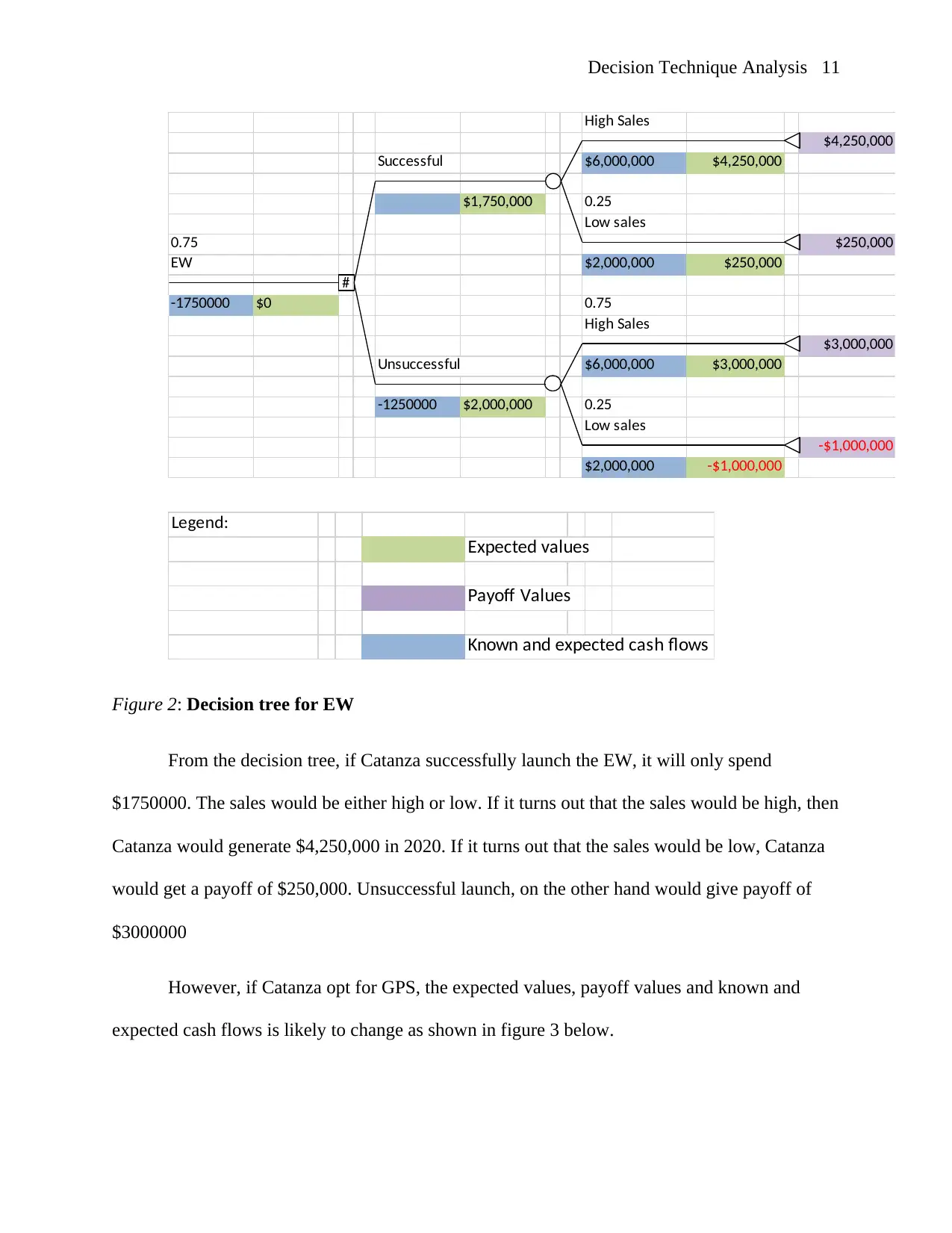
Decision Technique Analysis 11
High Sales
$4,250,000
Successful $6,000,000 $4,250,000
$1,750,000 0.25
Low sales
0.75 $250,000
EW $2,000,000 $250,000
#
-1750000 $0 0.75
High Sales
$3,000,000
Unsuccessful $6,000,000 $3,000,000
-1250000 $2,000,000 0.25
Low sales
-$1,000,000
$2,000,000 -$1,000,000
Legend:
Expected values
Payoff Values
Known and expected cash flows
Figure 2: Decision tree for EW
From the decision tree, if Catanza successfully launch the EW, it will only spend
$1750000. The sales would be either high or low. If it turns out that the sales would be high, then
Catanza would generate $4,250,000 in 2020. If it turns out that the sales would be low, Catanza
would get a payoff of $250,000. Unsuccessful launch, on the other hand would give payoff of
$3000000
However, if Catanza opt for GPS, the expected values, payoff values and known and
expected cash flows is likely to change as shown in figure 3 below.
High Sales
$4,250,000
Successful $6,000,000 $4,250,000
$1,750,000 0.25
Low sales
0.75 $250,000
EW $2,000,000 $250,000
#
-1750000 $0 0.75
High Sales
$3,000,000
Unsuccessful $6,000,000 $3,000,000
-1250000 $2,000,000 0.25
Low sales
-$1,000,000
$2,000,000 -$1,000,000
Legend:
Expected values
Payoff Values
Known and expected cash flows
Figure 2: Decision tree for EW
From the decision tree, if Catanza successfully launch the EW, it will only spend
$1750000. The sales would be either high or low. If it turns out that the sales would be high, then
Catanza would generate $4,250,000 in 2020. If it turns out that the sales would be low, Catanza
would get a payoff of $250,000. Unsuccessful launch, on the other hand would give payoff of
$3000000
However, if Catanza opt for GPS, the expected values, payoff values and known and
expected cash flows is likely to change as shown in figure 3 below.
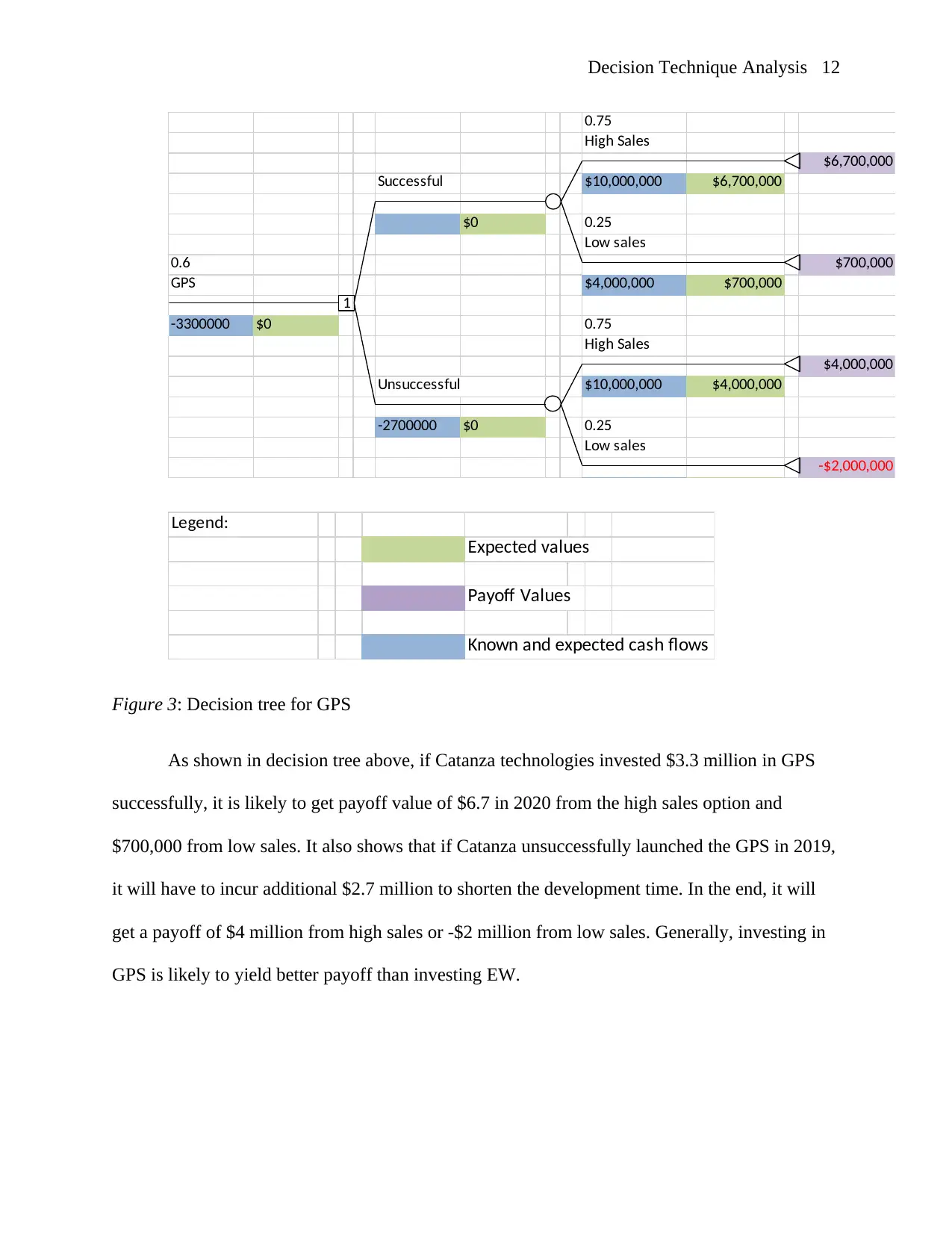
Decision Technique Analysis 12
0.75
High Sales
$6,700,000
Successful $10,000,000 $6,700,000
$0 0.25
Low sales
0.6 $700,000
GPS $4,000,000 $700,000
1
-3300000 $0 0.75
High Sales
$4,000,000
Unsuccessful $10,000,000 $4,000,000
-2700000 $0 0.25
Low sales
-$2,000,000
Legend:
Expected values
Payoff Values
Known and expected cash flows
Figure 3: Decision tree for GPS
As shown in decision tree above, if Catanza technologies invested $3.3 million in GPS
successfully, it is likely to get payoff value of $6.7 in 2020 from the high sales option and
$700,000 from low sales. It also shows that if Catanza unsuccessfully launched the GPS in 2019,
it will have to incur additional $2.7 million to shorten the development time. In the end, it will
get a payoff of $4 million from high sales or -$2 million from low sales. Generally, investing in
GPS is likely to yield better payoff than investing EW.
0.75
High Sales
$6,700,000
Successful $10,000,000 $6,700,000
$0 0.25
Low sales
0.6 $700,000
GPS $4,000,000 $700,000
1
-3300000 $0 0.75
High Sales
$4,000,000
Unsuccessful $10,000,000 $4,000,000
-2700000 $0 0.25
Low sales
-$2,000,000
Legend:
Expected values
Payoff Values
Known and expected cash flows
Figure 3: Decision tree for GPS
As shown in decision tree above, if Catanza technologies invested $3.3 million in GPS
successfully, it is likely to get payoff value of $6.7 in 2020 from the high sales option and
$700,000 from low sales. It also shows that if Catanza unsuccessfully launched the GPS in 2019,
it will have to incur additional $2.7 million to shorten the development time. In the end, it will
get a payoff of $4 million from high sales or -$2 million from low sales. Generally, investing in
GPS is likely to yield better payoff than investing EW.
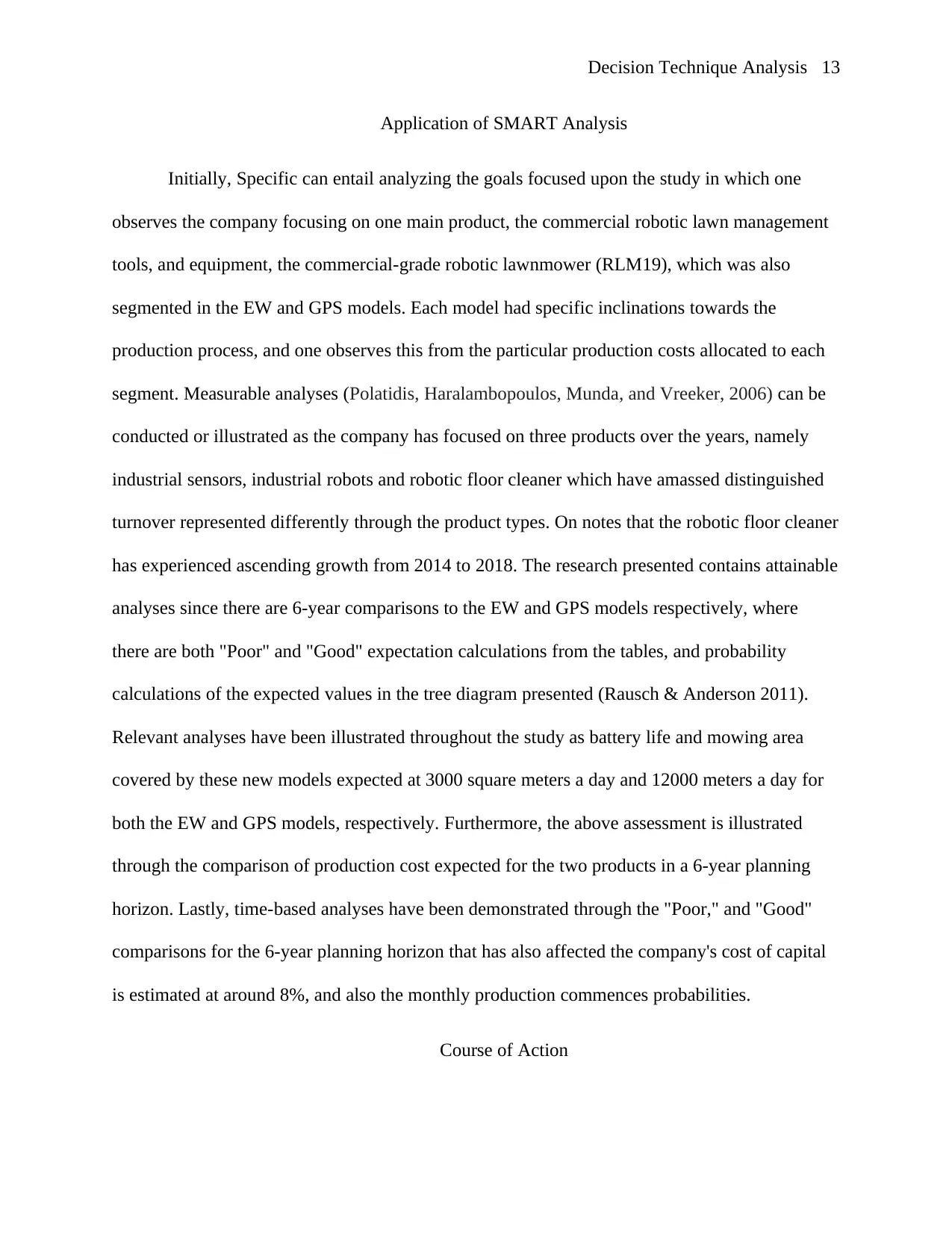
Decision Technique Analysis 13
Application of SMART Analysis
Initially, Specific can entail analyzing the goals focused upon the study in which one
observes the company focusing on one main product, the commercial robotic lawn management
tools, and equipment, the commercial-grade robotic lawnmower (RLM19), which was also
segmented in the EW and GPS models. Each model had specific inclinations towards the
production process, and one observes this from the particular production costs allocated to each
segment. Measurable analyses (Polatidis, Haralambopoulos, Munda, and Vreeker, 2006) can be
conducted or illustrated as the company has focused on three products over the years, namely
industrial sensors, industrial robots and robotic floor cleaner which have amassed distinguished
turnover represented differently through the product types. On notes that the robotic floor cleaner
has experienced ascending growth from 2014 to 2018. The research presented contains attainable
analyses since there are 6-year comparisons to the EW and GPS models respectively, where
there are both "Poor" and "Good" expectation calculations from the tables, and probability
calculations of the expected values in the tree diagram presented (Rausch & Anderson 2011).
Relevant analyses have been illustrated throughout the study as battery life and mowing area
covered by these new models expected at 3000 square meters a day and 12000 meters a day for
both the EW and GPS models, respectively. Furthermore, the above assessment is illustrated
through the comparison of production cost expected for the two products in a 6-year planning
horizon. Lastly, time-based analyses have been demonstrated through the "Poor," and "Good"
comparisons for the 6-year planning horizon that has also affected the company's cost of capital
is estimated at around 8%, and also the monthly production commences probabilities.
Course of Action
Application of SMART Analysis
Initially, Specific can entail analyzing the goals focused upon the study in which one
observes the company focusing on one main product, the commercial robotic lawn management
tools, and equipment, the commercial-grade robotic lawnmower (RLM19), which was also
segmented in the EW and GPS models. Each model had specific inclinations towards the
production process, and one observes this from the particular production costs allocated to each
segment. Measurable analyses (Polatidis, Haralambopoulos, Munda, and Vreeker, 2006) can be
conducted or illustrated as the company has focused on three products over the years, namely
industrial sensors, industrial robots and robotic floor cleaner which have amassed distinguished
turnover represented differently through the product types. On notes that the robotic floor cleaner
has experienced ascending growth from 2014 to 2018. The research presented contains attainable
analyses since there are 6-year comparisons to the EW and GPS models respectively, where
there are both "Poor" and "Good" expectation calculations from the tables, and probability
calculations of the expected values in the tree diagram presented (Rausch & Anderson 2011).
Relevant analyses have been illustrated throughout the study as battery life and mowing area
covered by these new models expected at 3000 square meters a day and 12000 meters a day for
both the EW and GPS models, respectively. Furthermore, the above assessment is illustrated
through the comparison of production cost expected for the two products in a 6-year planning
horizon. Lastly, time-based analyses have been demonstrated through the "Poor," and "Good"
comparisons for the 6-year planning horizon that has also affected the company's cost of capital
is estimated at around 8%, and also the monthly production commences probabilities.
Course of Action
Paraphrase This Document
Need a fresh take? Get an instant paraphrase of this document with our AI Paraphraser
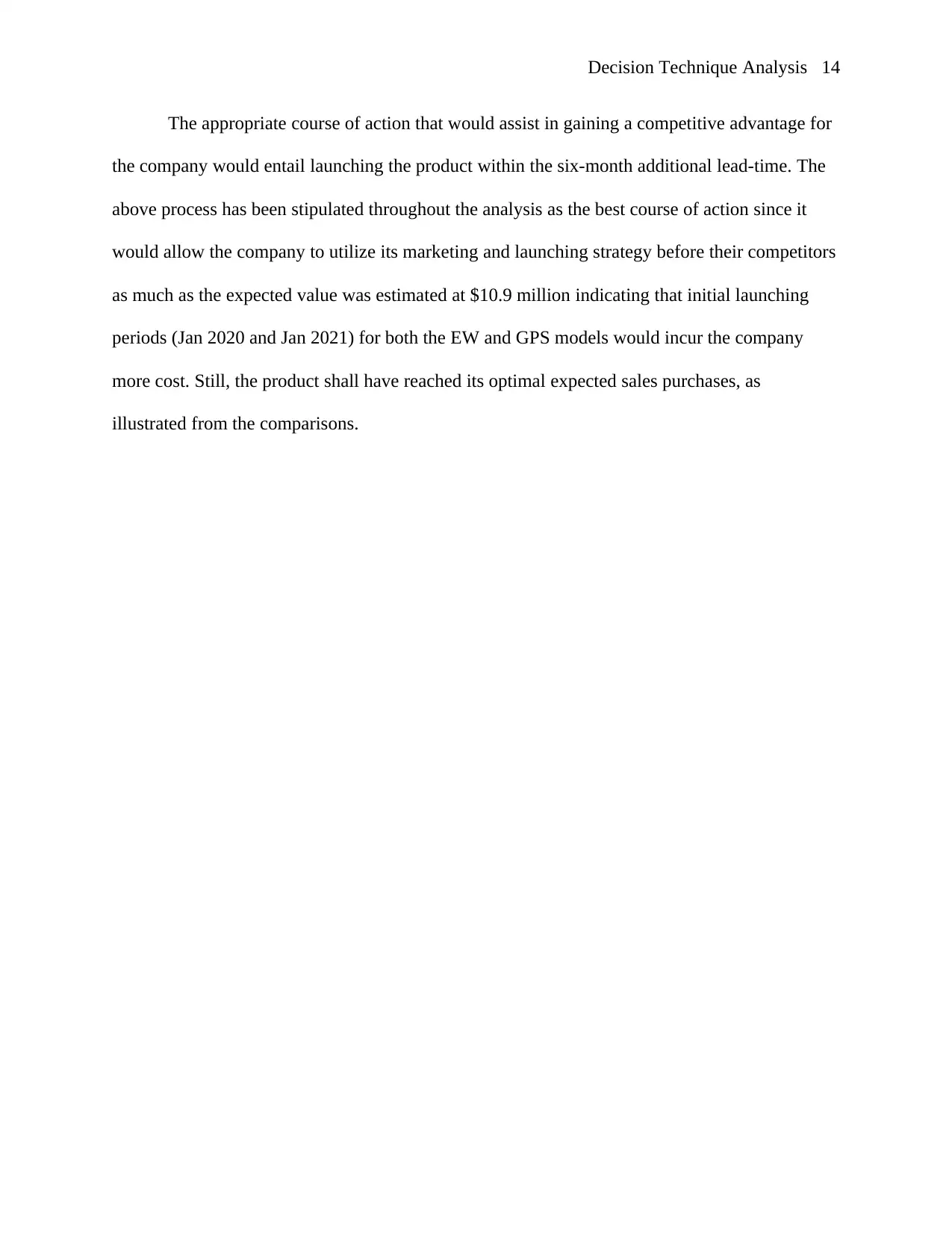
Decision Technique Analysis 14
The appropriate course of action that would assist in gaining a competitive advantage for
the company would entail launching the product within the six-month additional lead-time. The
above process has been stipulated throughout the analysis as the best course of action since it
would allow the company to utilize its marketing and launching strategy before their competitors
as much as the expected value was estimated at $10.9 million indicating that initial launching
periods (Jan 2020 and Jan 2021) for both the EW and GPS models would incur the company
more cost. Still, the product shall have reached its optimal expected sales purchases, as
illustrated from the comparisons.
The appropriate course of action that would assist in gaining a competitive advantage for
the company would entail launching the product within the six-month additional lead-time. The
above process has been stipulated throughout the analysis as the best course of action since it
would allow the company to utilize its marketing and launching strategy before their competitors
as much as the expected value was estimated at $10.9 million indicating that initial launching
periods (Jan 2020 and Jan 2021) for both the EW and GPS models would incur the company
more cost. Still, the product shall have reached its optimal expected sales purchases, as
illustrated from the comparisons.
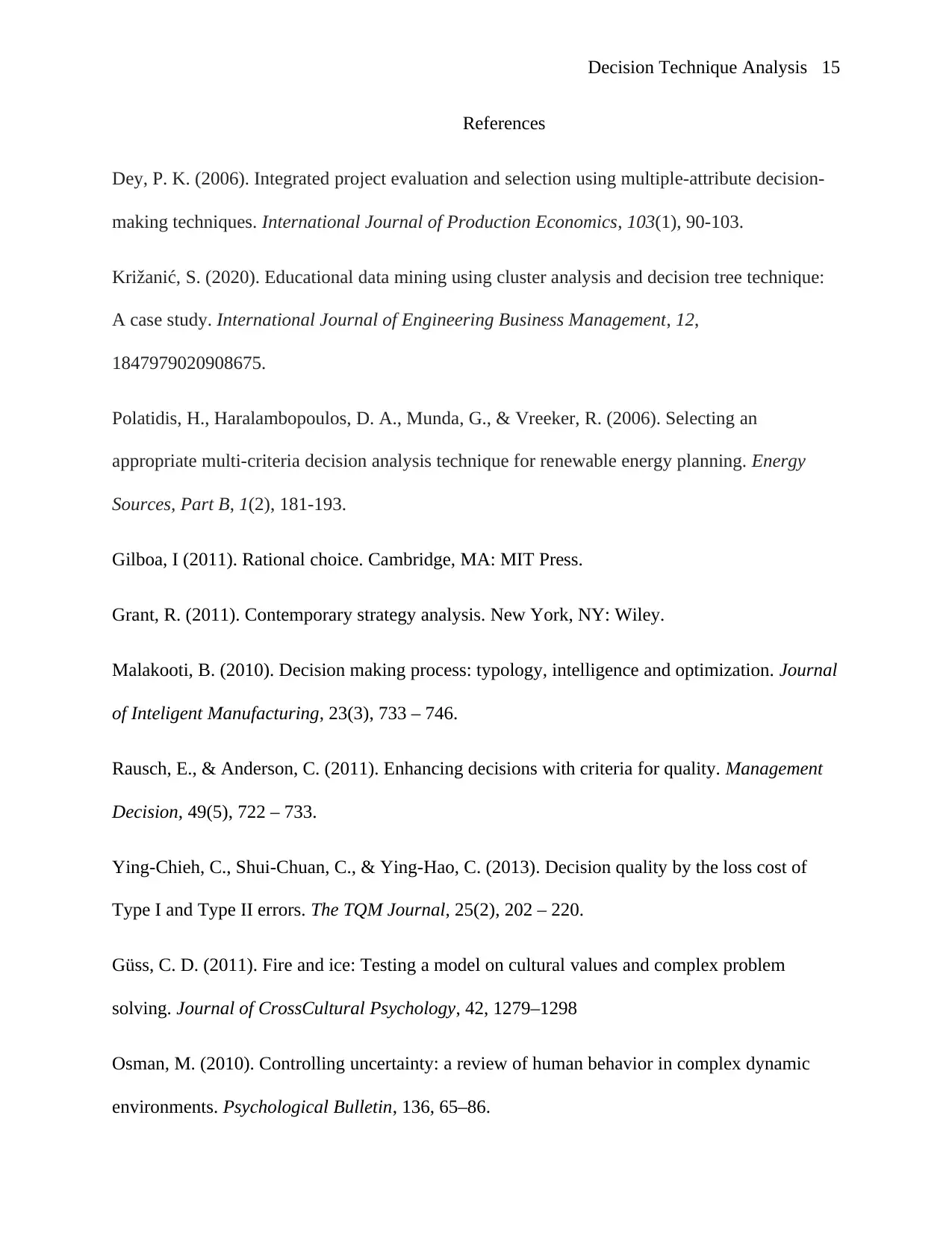
Decision Technique Analysis 15
References
Dey, P. K. (2006). Integrated project evaluation and selection using multiple-attribute decision-
making techniques. International Journal of Production Economics, 103(1), 90-103.
Križanić, S. (2020). Educational data mining using cluster analysis and decision tree technique:
A case study. International Journal of Engineering Business Management, 12,
1847979020908675.
Polatidis, H., Haralambopoulos, D. A., Munda, G., & Vreeker, R. (2006). Selecting an
appropriate multi-criteria decision analysis technique for renewable energy planning. Energy
Sources, Part B, 1(2), 181-193.
Gilboa, I (2011). Rational choice. Cambridge, MA: MIT Press.
Grant, R. (2011). Contemporary strategy analysis. New York, NY: Wiley.
Malakooti, B. (2010). Decision making process: typology, intelligence and optimization. Journal
of Inteligent Manufacturing, 23(3), 733 – 746.
Rausch, E., & Anderson, C. (2011). Enhancing decisions with criteria for quality. Management
Decision, 49(5), 722 – 733.
Ying-Chieh, C., Shui-Chuan, C., & Ying-Hao, C. (2013). Decision quality by the loss cost of
Type I and Type II errors. The TQM Journal, 25(2), 202 – 220.
Güss, C. D. (2011). Fire and ice: Testing a model on cultural values and complex problem
solving. Journal of CrossCultural Psychology, 42, 1279–1298
Osman, M. (2010). Controlling uncertainty: a review of human behavior in complex dynamic
environments. Psychological Bulletin, 136, 65–86.
References
Dey, P. K. (2006). Integrated project evaluation and selection using multiple-attribute decision-
making techniques. International Journal of Production Economics, 103(1), 90-103.
Križanić, S. (2020). Educational data mining using cluster analysis and decision tree technique:
A case study. International Journal of Engineering Business Management, 12,
1847979020908675.
Polatidis, H., Haralambopoulos, D. A., Munda, G., & Vreeker, R. (2006). Selecting an
appropriate multi-criteria decision analysis technique for renewable energy planning. Energy
Sources, Part B, 1(2), 181-193.
Gilboa, I (2011). Rational choice. Cambridge, MA: MIT Press.
Grant, R. (2011). Contemporary strategy analysis. New York, NY: Wiley.
Malakooti, B. (2010). Decision making process: typology, intelligence and optimization. Journal
of Inteligent Manufacturing, 23(3), 733 – 746.
Rausch, E., & Anderson, C. (2011). Enhancing decisions with criteria for quality. Management
Decision, 49(5), 722 – 733.
Ying-Chieh, C., Shui-Chuan, C., & Ying-Hao, C. (2013). Decision quality by the loss cost of
Type I and Type II errors. The TQM Journal, 25(2), 202 – 220.
Güss, C. D. (2011). Fire and ice: Testing a model on cultural values and complex problem
solving. Journal of CrossCultural Psychology, 42, 1279–1298
Osman, M. (2010). Controlling uncertainty: a review of human behavior in complex dynamic
environments. Psychological Bulletin, 136, 65–86.
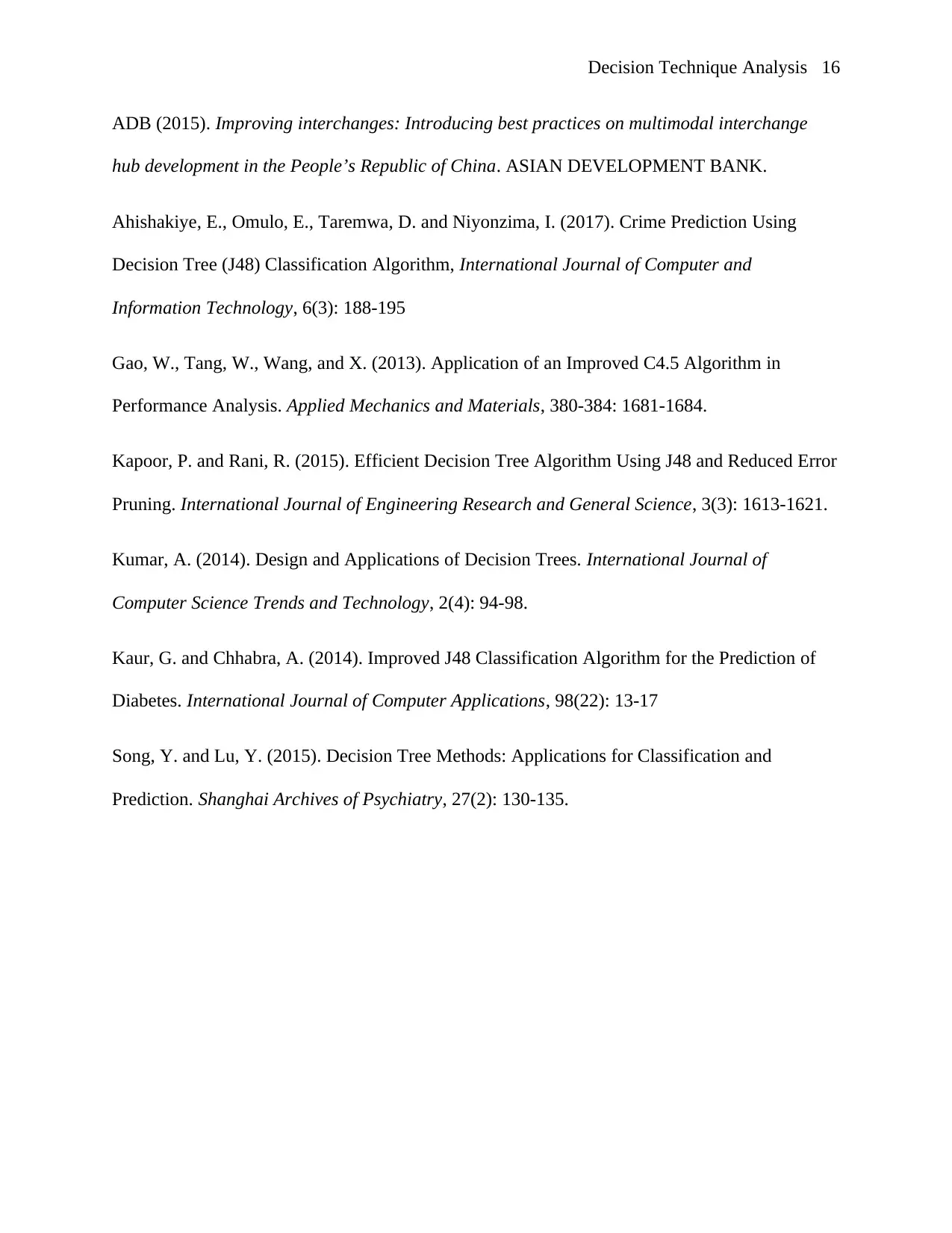
Decision Technique Analysis 16
ADB (2015). Improving interchanges: Introducing best practices on multimodal interchange
hub development in the People’s Republic of China. ASIAN DEVELOPMENT BANK.
Ahishakiye, E., Omulo, E., Taremwa, D. and Niyonzima, I. (2017). Crime Prediction Using
Decision Tree (J48) Classification Algorithm, International Journal of Computer and
Information Technology, 6(3): 188-195
Gao, W., Tang, W., Wang, and X. (2013). Application of an Improved C4.5 Algorithm in
Performance Analysis. Applied Mechanics and Materials, 380-384: 1681-1684.
Kapoor, P. and Rani, R. (2015). Efficient Decision Tree Algorithm Using J48 and Reduced Error
Pruning. International Journal of Engineering Research and General Science, 3(3): 1613-1621.
Kumar, A. (2014). Design and Applications of Decision Trees. International Journal of
Computer Science Trends and Technology, 2(4): 94-98.
Kaur, G. and Chhabra, A. (2014). Improved J48 Classification Algorithm for the Prediction of
Diabetes. International Journal of Computer Applications, 98(22): 13-17
Song, Y. and Lu, Y. (2015). Decision Tree Methods: Applications for Classification and
Prediction. Shanghai Archives of Psychiatry, 27(2): 130-135.
ADB (2015). Improving interchanges: Introducing best practices on multimodal interchange
hub development in the People’s Republic of China. ASIAN DEVELOPMENT BANK.
Ahishakiye, E., Omulo, E., Taremwa, D. and Niyonzima, I. (2017). Crime Prediction Using
Decision Tree (J48) Classification Algorithm, International Journal of Computer and
Information Technology, 6(3): 188-195
Gao, W., Tang, W., Wang, and X. (2013). Application of an Improved C4.5 Algorithm in
Performance Analysis. Applied Mechanics and Materials, 380-384: 1681-1684.
Kapoor, P. and Rani, R. (2015). Efficient Decision Tree Algorithm Using J48 and Reduced Error
Pruning. International Journal of Engineering Research and General Science, 3(3): 1613-1621.
Kumar, A. (2014). Design and Applications of Decision Trees. International Journal of
Computer Science Trends and Technology, 2(4): 94-98.
Kaur, G. and Chhabra, A. (2014). Improved J48 Classification Algorithm for the Prediction of
Diabetes. International Journal of Computer Applications, 98(22): 13-17
Song, Y. and Lu, Y. (2015). Decision Tree Methods: Applications for Classification and
Prediction. Shanghai Archives of Psychiatry, 27(2): 130-135.
1 out of 16
Your All-in-One AI-Powered Toolkit for Academic Success.
+13062052269
info@desklib.com
Available 24*7 on WhatsApp / Email
![[object Object]](/_next/static/media/star-bottom.7253800d.svg)
Unlock your academic potential
© 2024 | Zucol Services PVT LTD | All rights reserved.

